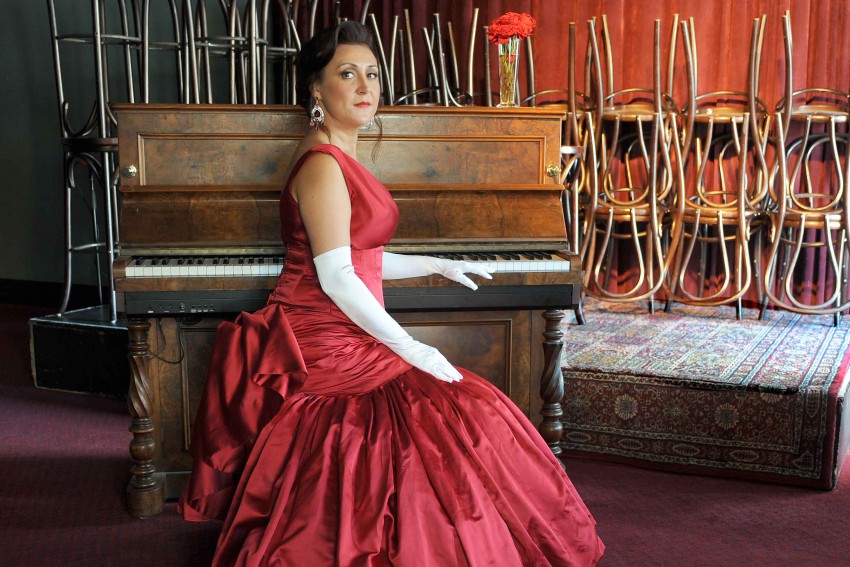Verdi’s La Traviata

Reflections on a high-class prostitute.
Reflections on a high-class prostitute. Three years ago, Opera Australia created an indelible image of La Traviata when it set Verdi’s masterpiece on Sydney Harbour with fireworks and a gigantic nine-metre tall chandelier suspended over the set to accompany its lavish party scenes. As she hurled her glass of champagne to the floor in a drunken fit, rarely before has Violetta, the opera’s central high-class prostitute, looked so flavoursomely decadent. But this is hardly the image one imagines Verdi had in mind when he saw play La dame aux Camélias by Alexandre Dumas and became passionate about turning it into an opera. A moving account of the beautiful and exceedingly clever Parisian courtesan Marie Duplessis, who enchanted Paris’s high society until she died of tuberculosis at 23 in 1847, this play caught Verdi’s imagination with its tragic, almost Shakespearean struggle of opposing forces. She has been called the ‘honest courtesan’, and Liszt, another in her trail of lovers after Dumas, described her as the “most absolute incarnation of woman who has ever existed”. It is said that despite the unsavouriness of her profession, she remained unswervingly truthful all through her short life. When we learn that Verdi originally called his opera Violetta – only later did he name it ‘the fallen woman’ (as La Traviata translates) – does it become apparent that he wanted to explore character, not frivolity. Maybe it takes a theatre director to see this, but Kate Cherry, who is directing the State Opera of SA’s new production of La Traviata, says she has always been fascinated with “complex characters who make their own decisions and take responsibility for the choices they make”. This makes Violetta Valéry, she says, as interesting as Blanche Du Bois in Tennessee Williams’ Streetcar Named Desire and Konstantin in Chekhov’s The Seagull – both plays that Cherry is directing this year with Perth’s Black Swan State Theatre Company. Cherry says her view of La Traviata is that it is a romance about a “woman who, in a pleasure-seeking world, learns for the first time to really love someone”. Violetta decides to abandon the high life to live with an adoring but cash-strapped countryman, Alfredo. “She sells her possessions so they can pay the rent,” says Cherry. “La Traviata is not a story of how or why she becomes a ‘fallen woman’, but rather of the person she is. Violetta has to face her own mortality and the fact she’s unable to have children. Despite this she reaches a maturity of love that asks one to reflect on this woman whom society would normally shun. But just because Violetta is a courtesan doesn’t mean she’s not a human being.” La Traviata’s tension is indeed that one find oneself sympathising with a figure who is despised as much as she is feted by people around her, and who, like a mirror, exposes their flaws of character. “I would question who is the fallen one,” says Cherry. “Ultimately, I see it as about the person who is considered the least honourable being the most honourable. Violetta keeps her word; she loves others above herself. Rather than asking for help, she makes all the sacrifices. Men see who they are through Violetta. So for Alfredo, she sacrificed her love and life so he can retain the respect of his father, who has asked her to leave after bringing shame on his family. In return, Alfredo completely humiliates her, and the father witnesses the cost of his request. Yet Violetta loves Alfredo so much that she decides his life will be better off without her in it – she thinks of him ahead of herself.” Contrasting with the opulence of La Traviata as typically staged – Franco Zeffirelli’s for the Metropolitan Opera, for example, were famously extravagant – Cherry says the look of her production will be “minimal”. Alone with just a fallen chandelier lying beside her, Violetta gazes into a ‘mirror box’ into which she glimpses her former party-filled life. “In this narcissistic world the mirror turns around to reveal the real Violetta inside,” Cherry explains. She and designer Christina Smith decided that all characters in the opera bar Violetta and her friend, Flora, will wear black costumes. “Over the top spectacle is a perfectly valid interpretation, but our decision is to distil everything down to tell the story in a very human version of the opera. If there is too much colour, it quickly overwhelms. You lose clarity”. It promises to be a production to make one think. Says Cherry: “Sometimes it takes time to see where the truth really exists. We’re in a fast paced, post-truth world in which we’re all in such a hurry to make decisions. We need to take time to properly consider things. I think we’ve never needed opera more”. Cherry’s production of La Traviata receives its premiere in Adelaide, after which it goes to New Zealand and Brisbane. Russian soprano Elvira Fatykhova takes the part of Violetta, Perth tenor Aldo Di Toro sings Alfredo, and Nicholas Carter conducts the Adelaide Symphony Orchestra. La Traviata Festival Theatre May 3, 6, 8 and 10 saopera.sa.gov.au Images: Chris Managan, Mango Pic